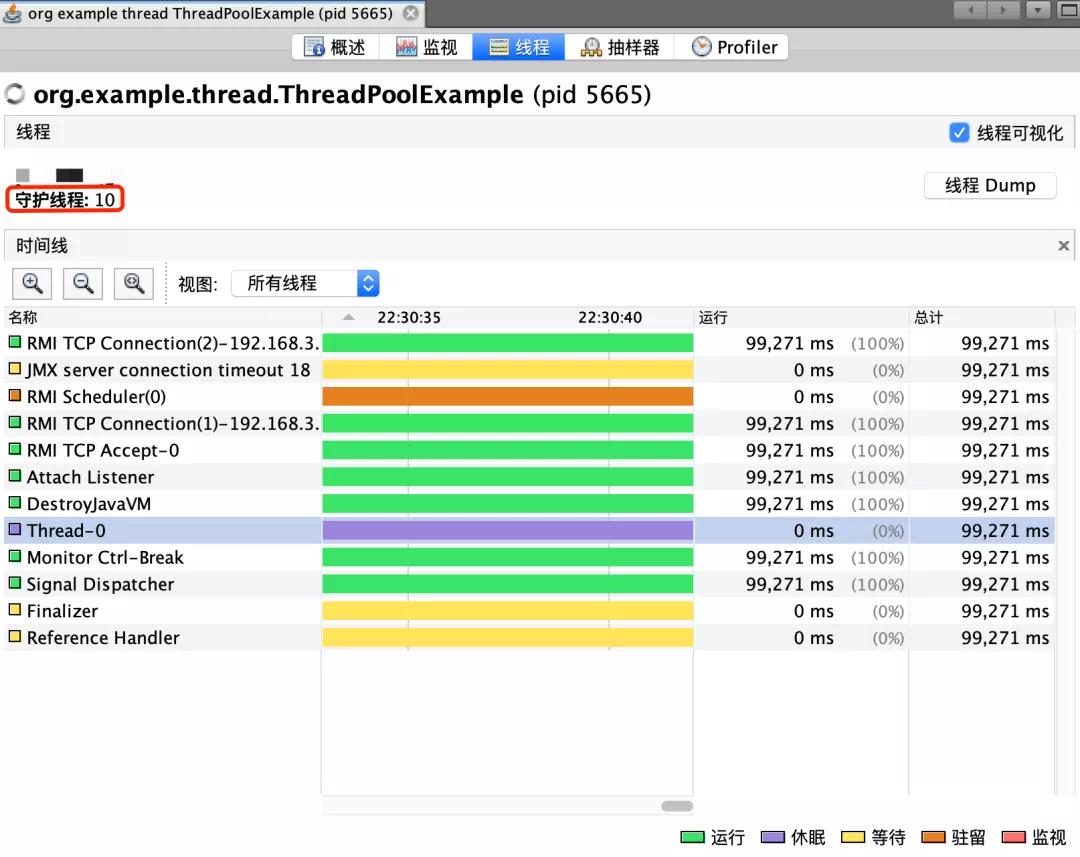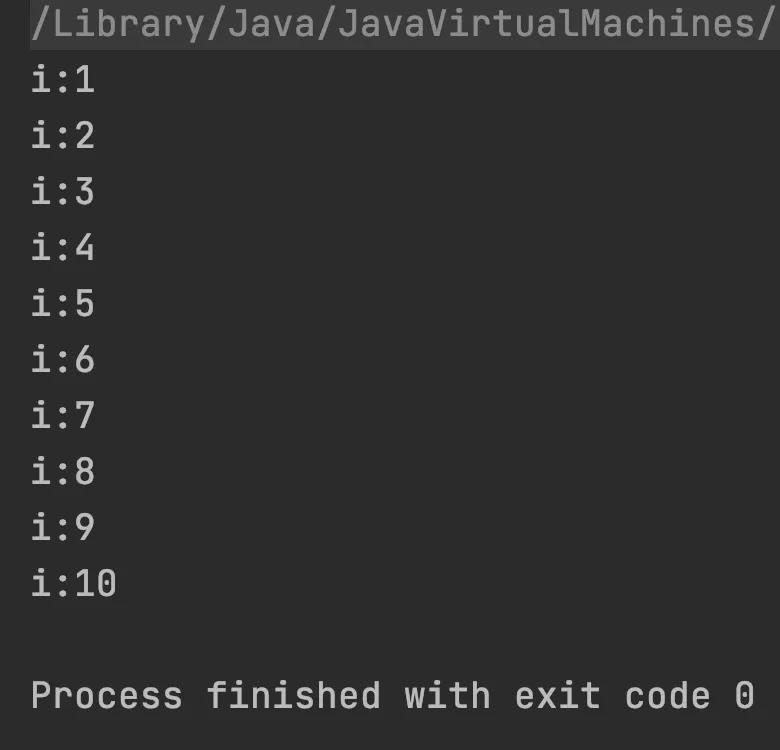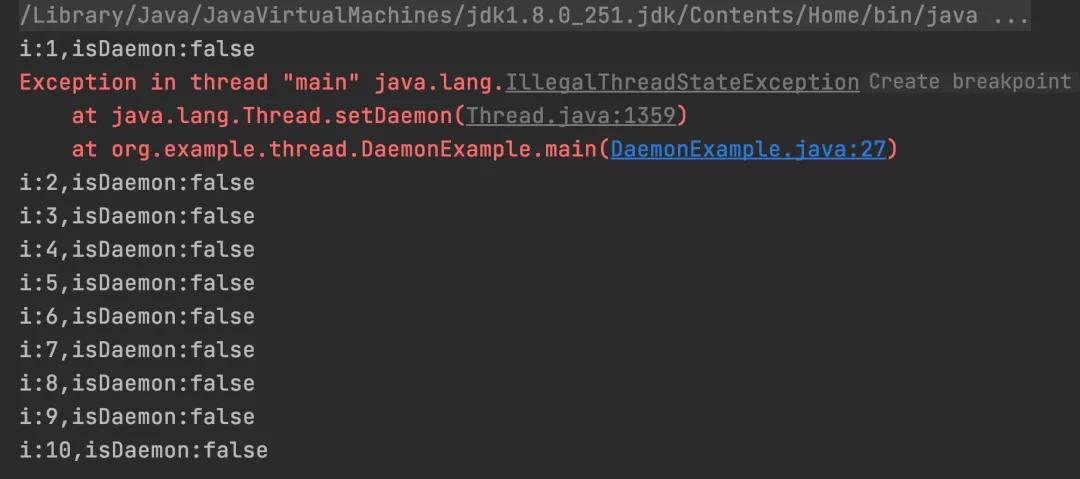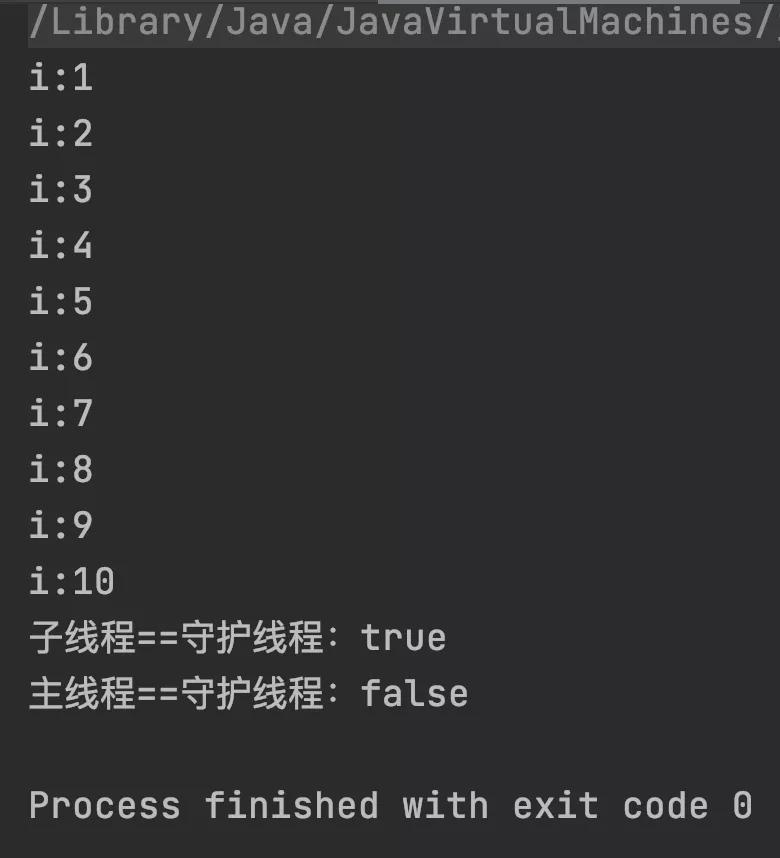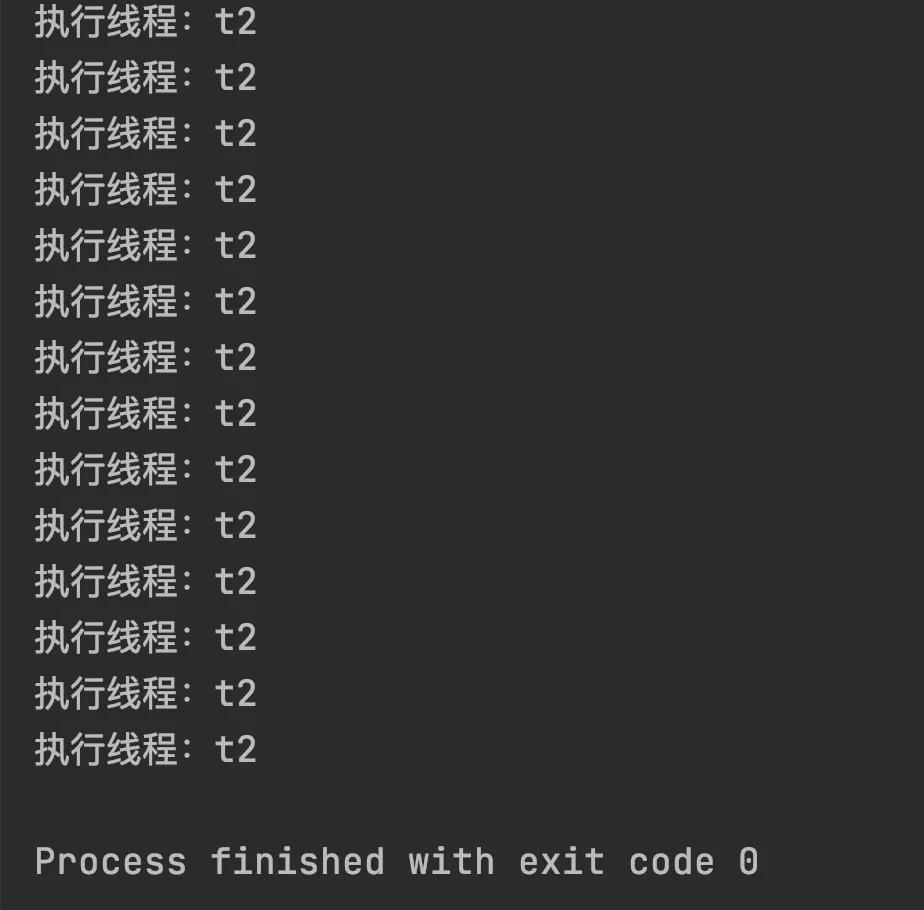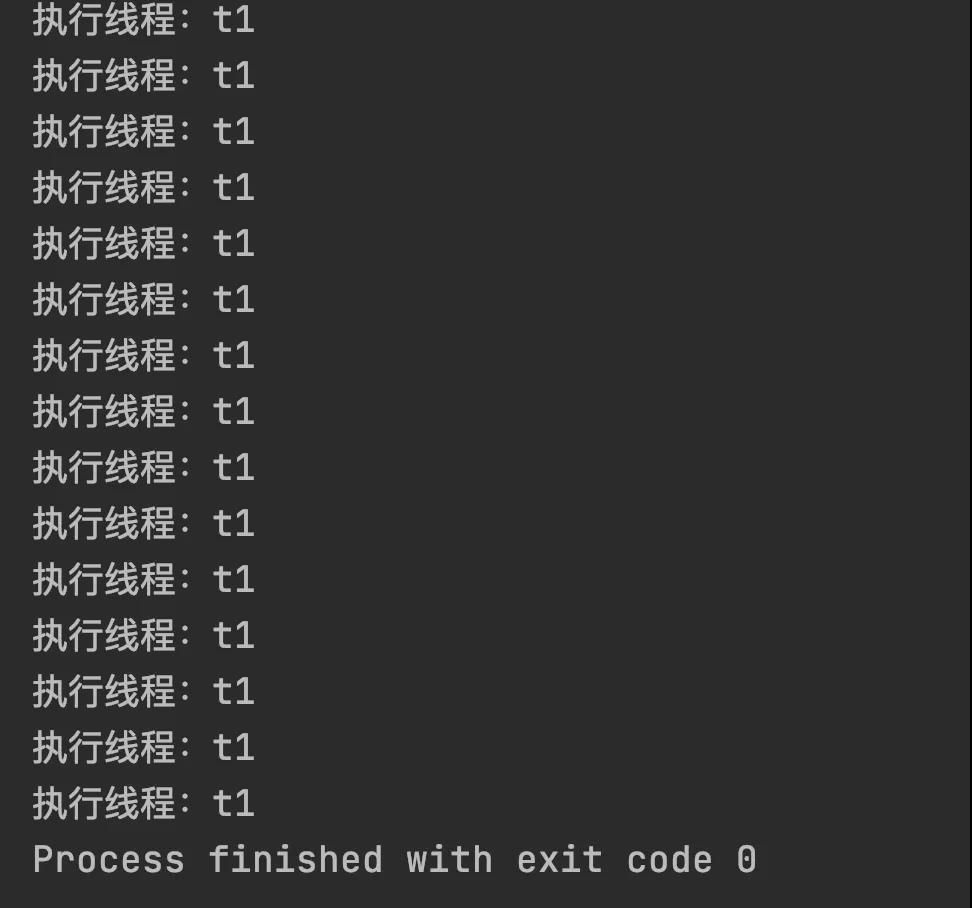Java中用戶線程和守護(hù)線程區(qū)別這么大?
本文轉(zhuǎn)載自微信公眾號「Java中文社群」,作者磊哥。轉(zhuǎn)載本文請聯(lián)系Java中文社群公眾號。
在 Java 語言中線程分為兩類:用戶線程和守護(hù)線程,而二者之間的區(qū)別卻鮮有人知,所以本文磊哥帶你來看二者之間的區(qū)別,以及守護(hù)線程需要注意的一些事項(xiàng)。
1.默認(rèn)用戶線程
Java 語言中無論是線程還是線程池,默認(rèn)都是用戶線程,因此用戶線程也被成為普通線程。
以線程為例,想要查看線程是否為守護(hù)線程只需通過調(diào)用 isDaemon() 方法查詢即可,如果查詢的值為 false 則表示不為守護(hù)線程,自然也就屬于用戶線程了,如下代碼所示:
- public static void main(String[] args) throws InterruptedException {
- Thread thread = new Thread(new Runnable() {
- @Override
- public void run() {
- System.out.println("我是子線程");
- }
- });
- System.out.println("子線程==守護(hù)線程:" + thread.isDaemon());
- System.out.println("主線程==守護(hù)線程:" + Thread.currentThread().isDaemon());
- }
以上程序的執(zhí)行結(jié)果為:
從上述結(jié)果可以看出,默認(rèn)情況下主線程和創(chuàng)建的新線程都為用戶線程。
PS:Thread.currentThread() 的意思是獲取執(zhí)行當(dāng)前代碼的線程實(shí)例。
2.主動修改為守護(hù)線程
守護(hù)線程(Daemon Thread)也被稱之為后臺線程或服務(wù)線程,守護(hù)線程是為用戶線程服務(wù)的,當(dāng)程序中的用戶線程全部執(zhí)行結(jié)束之后,守護(hù)線程也會跟隨結(jié)束。
守護(hù)線程的角色就像“服務(wù)員”,而用戶線程的角色就像“顧客”,當(dāng)“顧客”全部走了之后(全部執(zhí)行結(jié)束),那“服務(wù)員”(守護(hù)線程)也就沒有了存在的意義,所以當(dāng)一個程序中的全部用戶線程都結(jié)束執(zhí)行之后,那么無論守護(hù)線程是否還在工作都會隨著用戶線程一塊結(jié)束,整個程序也會隨之結(jié)束運(yùn)行。
那如何將默認(rèn)的用戶線程修改為守護(hù)線程呢?
這個問題要分為兩種情況來回答,首先如果是線程,則可以通過設(shè)置 setDaemon(true) 方法將用戶線程直接修改為守護(hù)線程,而如果是線程池則需要通過 ThreadFactory 將線程池中的每個線程都為守護(hù)線程才行,接下來我們分別來實(shí)現(xiàn)一下。
2.1 設(shè)置線程為守護(hù)線程
如果使用的是線程,可以通過 setDaemon(true) 方法將線程類型更改為守護(hù)線程,如下代碼所示:
- public static void main(String[] args) throws InterruptedException {
- Thread thread = new Thread(new Runnable() {
- @Override
- public void run() {
- System.out.println("我是子線程");
- }
- });
- // 設(shè)置子線程為守護(hù)線程
- thread.setDaemon(true);
- System.out.println("子線程==守護(hù)線程:" + thread.isDaemon());
- System.out.println("主線程==守護(hù)線程:" + Thread.currentThread().isDaemon());
- }
以上程序的執(zhí)行結(jié)果為:
2.2 設(shè)置線程池為守護(hù)線程
要把線程池設(shè)置為守護(hù)線程相對來說麻煩一些,需要將線程池中的所有線程都設(shè)置成守護(hù)線程,這個時候就需要使用 ThreadFactory 來定義線程池中每個線程的線程類型了,具體實(shí)現(xiàn)代碼如下:
- // 創(chuàng)建固定個數(shù)的線程池
- ExecutorService threadPool = Executors.newFixedThreadPool(10, new ThreadFactory() {
- @Override
- public Thread newThread(Runnable r) {
- Thread t = new Thread(r);
- // 設(shè)置線程為守護(hù)線程
- t.setDaemon(false);
- return t;
- }
- });
如下圖所示:
如上圖所示,可以看出,整個程序中有 10 個守護(hù)線程都是我創(chuàng)建的。其他幾種創(chuàng)建線程池的設(shè)置方式類似,都是通過 ThreadFactory 統(tǒng)一設(shè)置的,這里就不一一列舉了。
3.守護(hù)線程 VS 用戶線程
通過前面的學(xué)習(xí)我們可以創(chuàng)建兩種不同的線程類型了,那二者有什么差異呢?接下來我們使用一個小示例來看一下。
下面我們創(chuàng)建一個線程,分別將這個線程設(shè)置為用戶線程和守護(hù)線程,在每個線程中執(zhí)行一個 for 循環(huán),總共執(zhí)行 10 次信息打印,每次打印之后休眠 100 毫秒,來觀察程序的運(yùn)行結(jié)果。
3.1 用戶線程
新建的線程默認(rèn)就是用戶線程,因此我們無需對線程進(jìn)行任何特殊的處理,執(zhí)行 for 循環(huán)即可(總共執(zhí)行 10 次信息打印,每次打印之后休眠 100 毫秒),實(shí)現(xiàn)代碼如下:
- /**
- * Author:Java中文社群
- */
- public class DaemonExample {
- public static void main(String[] args) throws InterruptedException {
- Thread thread = new Thread(new Runnable() {
- @Override
- public void run() {
- for (int i = 1; i <= 10; i++) {
- // 打印 i 信息
- System.out.println("i:" + i);
- try {
- // 休眠 100 毫秒
- Thread.sleep(100);
- } catch (InterruptedException e) {
- e.printStackTrace();
- }
- }
- }
- });
- // 啟動線程
- thread.start();
- }
- }
以上程序執(zhí)行結(jié)果如下:
從上述結(jié)果可以看出,當(dāng)程序執(zhí)行完 10 次打印之后才會正常結(jié)束進(jìn)程。
3.2 守護(hù)線程
- /**
- * Author:Java中文社群
- */
- public class DaemonExample {
- public static void main(String[] args) throws InterruptedException {
- Thread thread = new Thread(new Runnable() {
- @Override
- public void run() {
- for (int i = 1; i <= 10; i++) {
- // 打印 i 信息
- System.out.println("i:" + i);
- try {
- // 休眠 100 毫秒
- Thread.sleep(100);
- } catch (InterruptedException e) {
- e.printStackTrace();
- }
- }
- }
- });
- // 設(shè)置為守護(hù)線程
- thread.setDaemon(true);
- // 啟動線程
- thread.start();
- }
- }
以上程序執(zhí)行結(jié)果如下:
從上述結(jié)果可以看出,當(dāng)線程設(shè)置為守護(hù)線程之后,整個程序不會等守護(hù)線程 for 循環(huán) 10 次之后再進(jìn)行關(guān)閉,而是當(dāng)主線程結(jié)束之后,守護(hù)線程只執(zhí)行了一次循環(huán)就結(jié)束運(yùn)行了,由此可以看出守護(hù)線程和用戶線程的不同。
3.3 小結(jié)
守護(hù)線程是為用戶線程服務(wù)的,當(dāng)一個程序中的所有用戶線程都執(zhí)行完成之后程序就會結(jié)束運(yùn)行,程序結(jié)束運(yùn)行時不會管守護(hù)線程是否正在運(yùn)行,由此我們可以看出守護(hù)線程在 Java 體系中權(quán)重是比較低的。
4.守護(hù)線程注意事項(xiàng)
守護(hù)線程的使用需要注意以下三個問題:
- 守護(hù)線程的設(shè)置 setDaemon(true) 必須要放在線程的 start() 之前,否則程序會報(bào)錯。
- 在守護(hù)線程中創(chuàng)建的所有子線程都是守護(hù)線程。
- 使用 jojn() 方法會等待一個線程執(zhí)行完,無論此線程是用戶線程還是守護(hù)線程。
接下來我們分別演示一下,以上的注意事項(xiàng)。
4.1 setDaemon 執(zhí)行順序
當(dāng)我們將 setDaemon(true) 設(shè)置在 start() 之后,如下代碼所示:
- public static void main(String[] args) throws InterruptedException {
- Thread thread = new Thread(new Runnable() {
- @Override
- public void run() {
- for (int i = 1; i <= 10; i++) {
- // 打印 i 信息
- System.out.println("i:" + i + ",isDaemon:" +
- Thread.currentThread().isDaemon());
- try {
- // 休眠 100 毫秒
- Thread.sleep(100);
- } catch (InterruptedException e) {
- e.printStackTrace();
- }
- }
- }
- });
- // 啟動線程
- thread.start();
- // 設(shè)置為守護(hù)線程
- thread.setDaemon(true);
- }
以上程序執(zhí)行結(jié)果如下:
從上述結(jié)果可以看出,當(dāng)我們將 setDaemon(true) 設(shè)置在 start() 之后,不但程序的執(zhí)行會報(bào)錯,而且設(shè)置的守護(hù)線程也不會生效。
4.2 守護(hù)線程的子線程
- public static void main(String[] args) throws InterruptedException {
- Thread thread = new Thread(new Runnable() {
- @Override
- public void run() {
- Thread thread2 = new Thread(new Runnable() {
- @Override
- public void run() {
- }
- });
- System.out.println("守護(hù)線程的子線程 thread2 isDaemon:" +
- thread2.isDaemon());
- }
- });
- // 設(shè)置為守護(hù)線程
- thread.setDaemon(true);
- // 啟動線程
- thread.start();
- Thread.sleep(1000);
- }
以上程序執(zhí)行結(jié)果如下:
從上述結(jié)果可以看出,守護(hù)線程中創(chuàng)建的子線程,默認(rèn)情況下也屬于守護(hù)線程。
4.3 join 與守護(hù)線程
通過 3.2 部分的內(nèi)容我們可以看出,默認(rèn)情況下程序結(jié)束并不會等待守護(hù)線程執(zhí)行完,而當(dāng)我們調(diào)用線程的等待方法 join() 時,執(zhí)行的結(jié)果就會和 3.2 的結(jié)果有所不同,下面我們一起來看吧,示例代碼如下:
- public static void main(String[] args) throws InterruptedException {
- Thread thread = new Thread(new Runnable() {
- @Override
- public void run() {
- for (int i = 1; i <= 10; i++) {
- // 打印 i 信息
- System.out.println("i:" + i);
- try {
- // 休眠 100 毫秒
- Thread.sleep(100);
- } catch (InterruptedException e) {
- e.printStackTrace();
- }
- }
- }
- });
- // 設(shè)置為守護(hù)線程
- thread.setDaemon(true);
- // 啟動線程
- thread.start();
- // 等待線程執(zhí)行完
- thread.join();
- System.out.println("子線程==守護(hù)線程:" + thread.isDaemon());
- System.out.println("主線程==守護(hù)線程:" + Thread.currentThread().isDaemon());
- }
以上程序執(zhí)行結(jié)果如下:
通過上述結(jié)果我們可以看出,即使是守護(hù)線程,當(dāng)程序中調(diào)用 join() 方法時,程序依然會等待守護(hù)線程執(zhí)行完成之后再結(jié)束進(jìn)程。
5.守護(hù)線程應(yīng)用場景
守護(hù)線程的典型應(yīng)用場景就是垃圾回收線程,當(dāng)然還有一些場景也非常適合使用守護(hù)線程,比如服務(wù)器端的健康檢測功能,對于一個服務(wù)器來說健康檢測功能屬于非核心非主流的服務(wù)業(yè)務(wù),像這種為了主要業(yè)務(wù)服務(wù)的業(yè)務(wù)功能就非常合適使用守護(hù)線程,當(dāng)程序中的主要業(yè)務(wù)都執(zhí)行完成之后,服務(wù)業(yè)務(wù)也會跟隨者一起銷毀。
6.守護(hù)線程的執(zhí)行優(yōu)先級
首先來說,線程的類型(用戶線程或守護(hù)線程)并不影響線程執(zhí)行的優(yōu)先級,如下代碼所示,定義一個用戶線程和守護(hù)線程,分別執(zhí)行 10 萬次循環(huán),通過觀察最后的打印結(jié)果來確認(rèn)線程類型對程序執(zhí)行優(yōu)先級的影響。
- public class DaemonExample {
- private static final int count = 100000;
- public static void main(String[] args) throws InterruptedException {
- // 定義任務(wù)
- Runnable runnable = new Runnable() {
- @Override
- public void run() {
- for (int i = 0; i < count; i++) {
- System.out.println("執(zhí)行線程:" + Thread.currentThread().getName());
- }
- }
- };
- // 創(chuàng)建守護(hù)線程 t1
- Thread t1 = new Thread(runnable, "t1");
- // 設(shè)置為守護(hù)線程
- t1.setDaemon(true);
- // 啟動線程
- t1.start();
- // 創(chuàng)建用戶線程 t2
- Thread t2 = new Thread(runnable, "t2");
- // 啟動線程
- t2.start();
- }
- }
以上程序執(zhí)行結(jié)果如下:
通過上述結(jié)果可以看出,線程的類型不管是守護(hù)線程還是用戶線程對程序執(zhí)行的優(yōu)先級是沒有任何影響的,而當(dāng)我們將 t2 的優(yōu)先級調(diào)整為最大時,整個程序的運(yùn)行結(jié)果就完全不同了,如下代碼所示:
- public class DaemonExample {
- private static final int count = 100000;
- public static void main(String[] args) throws InterruptedException {
- // 定義任務(wù)
- Runnable runnable = new Runnable() {
- @Override
- public void run() {
- for (int i = 0; i < count; i++) {
- System.out.println("執(zhí)行線程:" + Thread.currentThread().getName());
- }
- }
- };
- // 創(chuàng)建守護(hù)線程 t1
- Thread t1 = new Thread(runnable, "t1");
- // 設(shè)置為守護(hù)線程
- t1.setDaemon(true);
- // 啟動線程
- t1.start();
- // 創(chuàng)建用戶線程 t2
- Thread t2 = new Thread(runnable, "t2");
- // 設(shè)置 t2 的優(yōu)先級為最高
- t2.setPriority(Thread.MAX_PRIORITY);
- // 啟動線程
- t2.start();
- }
- }
以上程序執(zhí)行結(jié)果如下:
通過上述的結(jié)果可以看出,程序的類型和程序執(zhí)行的優(yōu)先級是沒有任何關(guān)系,當(dāng)新創(chuàng)建的線程默認(rèn)的優(yōu)先級都是 5 時,無論是守護(hù)線程還是用戶線程,它們執(zhí)行的優(yōu)先級都是相同的,當(dāng)將二者的優(yōu)先級設(shè)置不同時,執(zhí)行的結(jié)果也會隨之改變(優(yōu)先級設(shè)置的越高,最早被執(zhí)行的概率也越大)。
7.總結(jié)
在 Java 語言中線程分為用戶線程和守護(hù)線程,守護(hù)線程是用來為用戶線程服務(wù)的,當(dāng)一個程序中的所有用戶線程都結(jié)束之后,無論守護(hù)線程是否在工作都會跟隨用戶線程一起結(jié)束。守護(hù)線程從業(yè)務(wù)邏輯層面來看權(quán)重比較低,但對于線程調(diào)度器來說無論是守護(hù)線程還是用戶線程,在優(yōu)先級相同的情況下被執(zhí)行的概率都是相同的。守護(hù)線程的經(jīng)典使用場景是垃圾回收線程,守護(hù)線程中創(chuàng)建的線程默認(rèn)情況下也都是守護(hù)線程。
















